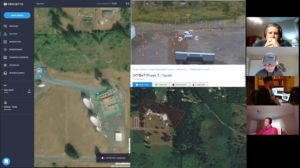
Verizon is dialing up a new mission for its drone subsidiary – wildfire damage inspection.
The telecom announced today the FAA granted Portland-based Skyward a temporary waiver allowing company pilots to fly Percepto Sparrow drones from their homes to inspect critical communications infrastructure near the Big Hollow wildfire in Washington. So far, the blaze has consumed more than 24,000 acres and fueled mandatory evacuation orders.
Company officials say the waiver permits 24-hour operation with less than three miles visibility and without an on-site pilot/observer.
“At a moment when we are facing dangerous consequences of climate change and coping with a global pandemic, maintaining the Verizon network has never been more important,” Verizon Chief Strategy Officer Rima Qureshi said.
“Innovations in airborne technology have enhanced our ability to inspect our sites without putting engineers in harm’s way and provide our first responders with reliable communications. We appreciate the FAA’s swift action in granting the waiver, which allows us to deploy a network-connected drone and provide critical services, safely and effectively.”
The FAA has granted thousands of Part 107 beyond-visual-line-of-sight waivers to applicants who demonstrate safe flying practices. Skyward’s waiver is unique since most permits require an onsite pilot or visual observer.
“Skyward spent nearly a year testing and proving it could safely fly without onsite personnel. In addition to the groundbreaking nature of the flight, the waiver itself is a milestone for remote deployment of drones in the U.S.,” a Skyward spokesperson noted.
“We’ve built a BVLOS capability consisting of a remotely deployable drone system, weather monitoring systems like those used at airports, Skyward’s Aviation Management Platform, and state-of-the-art airborne safety systems that allow us to check the surrounding airspace for other aircraft,” said Skyward Director of Aviation Development Centers, who goes by the name X.
“Verizon’s 4G LTE network connected these systems, giving the team’s operations lead in Alaska a near real-time picture of the operation from 1,600 miles away.”
A Verizon statement added:
“The location of the critical communications infrastructure itself is within blocks of a Level 1 evacuation order and the air quality was unsafe for humans. This operation not only allowed Verizon engineers to confirm the integrity and operability of its infrastructure was not impacted, it also allowed them to do so without putting people in harm’s way.”
Verizon’s announcement is welcome news for the drone community after several heated encounters between rogue UAV pilots and firefighters. Last month, FAA officials dropped charges against an unidentified person who flew a drone over restricted airspace at the Bighorn wildfire scene in Arizona.
The agency wouldn’t say when the drone flight took place and refused to identify the name or gender of the pilot. However, firefighting officials temporarily suspended aerial operations in early June.
Last year, Arizona State Forestry officials spotted a drone over the Coldwater fire – a blaze that burned more than 6,000 acres of the Coconino National Forest. The sighting forced officials to temporarily ground a firefighting helicopter.
Verizon-Skyward Timeline
In 2017, Verizon acquired Skyward, marking a milestone in drone tech’s role in multi-national corporate strategy. The global telecom joined Intel in becoming one of the first Fortune 500 company to invest in the drone sector.
In 2018, Skyward, along with other leading drone companies, was named as a partner in the FAA’s Low Altitude Authorization and Notification Capability (LAANC) initiative. The collaborative program between the FAA and drone industry stakeholders provides near real-time processing of airspace authorizations for Part 107 drone operators seeking to fly in controlled airspace.
Jason is a longstanding contributor to DroneLife with an avid interest in all things tech. He focuses on anti-drone technologies and the public safety sector; police, fire, and search and rescue.
Beginning his career as a journalist in 1996, Jason has since written and edited thousands of engaging news articles, blog posts, press releases and online content.
Email Jason
TWITTER:@JasonPReagan
Subscribe to DroneLife here.